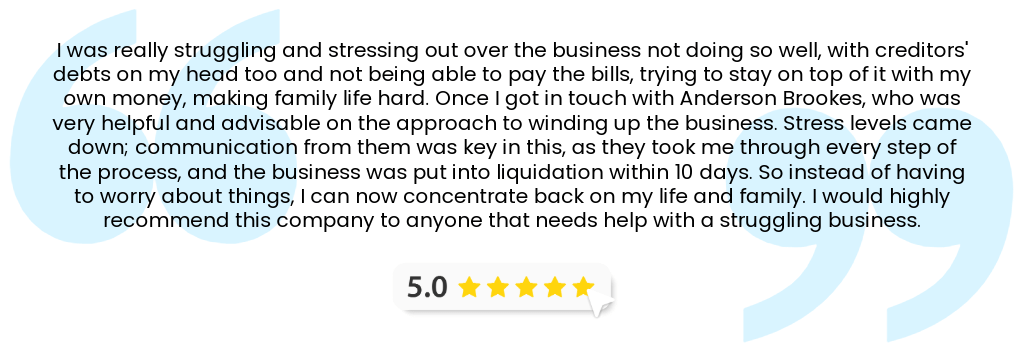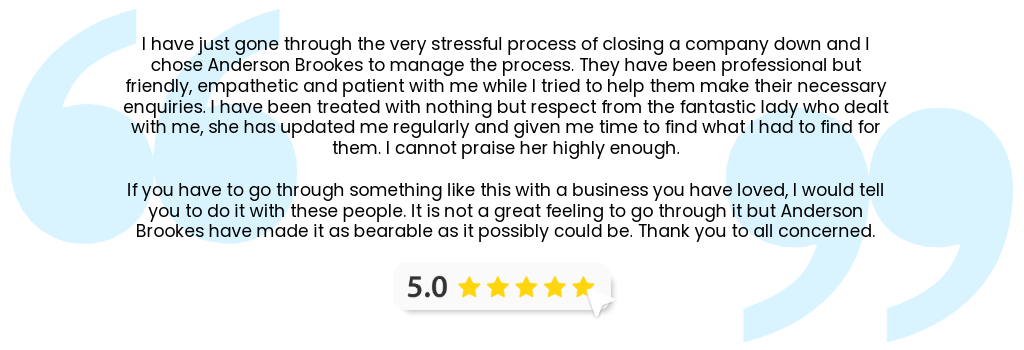
Receiving a winding-up petition is one of the most serious threats a company can face. It’s a legal step that can begin the process of closing a business down for good. For companies already under pressure, it can trigger a domino effect: frozen bank accounts, lost contracts, and immediate reputational damage.
The good news? You still have options. Many companies assume there’s no way back once a petition is served, but that’s not always the case. With the right advice (and fast intervention), you can challenge the petition, negotiate with creditors, and explore rescue options that could stabilise the business and protect your future.
In this guide, we’ll walk through exactly what a winding-up petition involves, what it means for you, and how we at Anderson Brookes can help you take control of the situation before it’s too late.
What Is a Winding-Up Petition?
A winding-up petition is a formal legal request to close down a company due to unpaid debts. It’s usually filed by a creditor, such as HMRC or a supplier, and submitted to the court. If successful, the petition results in a winding-up order, which forces the company into compulsory liquidation.
The process typically begins when a creditor is owed £750 or more and believes the debt is not being disputed. Often, this follows a statutory demand or repeated efforts to collect the debt through informal channels. If the court agrees that the debt is valid and the company cannot pay, it appoints an official receiver to liquidate the business and distribute its assets.
Unlike a voluntary liquidation, which is initiated by the company itself, a winding-up petition is adversarial. It’s a sign that control is slipping away. Once the petition is advertised in The Gazette, usually seven days after it’s served, the consequences escalate quickly. Bank accounts may be frozen, trade credit can be withdrawn, and customers may lose confidence overnight.
According to the UK Insolvency Service, there were over 1,200 compulsory liquidations in the first quarter of 2024 alone, a 25% increase compared to the previous year. Many of these began with winding-up petitions filed by HMRC, which has become increasingly assertive in recovering unpaid VAT and Corporation Tax since the post-COVID support measures ended.
To understand how the process unfolds, our step-by-step guide to company liquidation provides a clear overview. It explains what happens from the moment a petition is served through to the appointment of the liquidator and the final closure of the company.
Why Directors Should Take a Winding-Up Petition Seriously
A winding-up petition isn’t just a warning sign. It’s a direct threat to the survival of the business and a potential risk to directors personally. Ignoring it, or failing to act quickly, can lead to irreversible damage both financially and legally.
Once a petition is served, you have limited time to respond. If it progresses to a winding-up order, the company is placed into compulsory liquidation, and its assets are seized. Directors lose control at that point. An official receiver is appointed to investigate the company’s affairs and distribute its remaining assets to creditors. This process is public and can be reputationally damaging.
The risks go further than business closure. During the liquidation process, the official receiver or appointed liquidator will examine the conduct of the directors. Of particular interest is any suspicion of wrongful trading: where directors continued to incur debts knowing the company was insolvent. If evidence of this is found, they can be held personally liable. Claims can also be brought for transactions at undervalue, preferential payments, or misuse of company funds.
It’s also worth noting that the petition, once advertised, can prevent the company from making important payments or entering new contracts. Many banks freeze accounts automatically. Trade suppliers may withdraw credit terms, and employees could start looking for more stable work. In many cases, the petition itself causes damage long before the court hearing takes place.
If you’re considering winding down a company, a Creditors’ Voluntary Liquidation (CVL) offers a more controlled route. Unlike a court-ordered liquidation, a CVL allows directors to appoint their own insolvency practitioner and manage the timing of the closure. You can learn more about how this works in our guide to voluntary liquidation for limited companies.
Acting early doesn’t just open up more options; it can also reduce the risk of personal liability. That’s why taking expert advice at the first sign of a petition is essential before the situation escalates out of your hands.
Responding to a Winding-Up Petition: Key Steps
Time is critical once a winding-up petition has been served. The window to act is narrow, and the risks increase with every passing day. Here are the essential steps to take if your company receives a petition.
1. Seek Immediate Advice from an Insolvency Practitioner
The first priority is to speak with a licensed insolvency practitioner. At Anderson Brookes, we offer regulated advice with no upfront fees. An early assessment can reveal whether the petition can be challenged, settled, or redirected through a more strategic route, such as a Company Voluntary Arrangement (CVA).
2. Check for Validity
Not all petitions are accurate or legally sound. The debt may be disputed, overstated, or already paid. If there’s a genuine dispute, it may be possible to apply for an injunction to stop the petition being advertised in The Gazette. Once the notice goes public, reputational damage and frozen bank accounts often follow, even if the petition is later dismissed.
3. Explore Settlement or Negotiation
If the debt is valid, repayment, whether in full or by agreement, is sometimes the fastest way to avoid liquidation. Anderson Brookes can often assist in negotiating with creditors, including HMRC. In some cases, structured repayment plans or formal agreements can be reached outside of court, preventing further escalation.
4. Consider a Rescue Strategy
If the company has underlying viability, a CVA or administration may offer a route forward. A CVA allows you to repay a proportion of debts over time while continuing to trade, while administration offers legal protection and the chance to restructure or sell the business. Our article on administration as a second chance outlines how this can help.
5. Prepare for the Hearing
If no resolution is reached, the case will proceed to a court hearing. You’ll need to present evidence and potentially oppose the petition. Legal representation may be necessary at this stage, particularly if you’re challenging the validity or requesting an adjournment. Acting early gives you a stronger position.
Responding to a petition is about speed, accuracy, and strategy. With expert support, it may be possible to halt the process, save the business, or at least exit in a way that protects your interests.

Alternatives to Compulsory Liquidation
Facing a winding-up petition doesn’t automatically mean the end of your company. There are several formal options available that can either rescue the business or allow it to close in a more structured and less damaging way. Choosing the right approach depends on the company’s financial position, prospects, and creditor relationships.
Company Voluntary Arrangement (CVA)
A Company Voluntary Arrangement allows you to reach a legally binding agreement with your creditors to repay a portion of your debts over time, usually between three to five years. The business continues to trade, and directors retain control. CVAs are often suitable for companies with a solid underlying business that’s been hit by cash flow issues or unexpected liabilities.
At Anderson Brookes, we specialise in helping companies propose CVAs that are fair, realistic, and likely to gain creditor approval. We handle everything from proposal drafting to negotiations, so you can focus on recovery.
Administration
If creditor pressure is already intense, placing the company into administration may provide breathing space. This process gives the company legal protection from creditors while an insolvency practitioner reviews rescue options, restructures the business, or arranges a sale of assets to preserve jobs and value.
Administration is especially useful when a viable business model is being dragged down by specific debts or litigation. It’s also a tool for preventing a winding-up order from taking effect.
Creditors’ Voluntary Liquidation (CVL)
If continuing to trade isn’t feasible, a Creditors’ Voluntary Liquidation gives directors more control than compulsory liquidation. You choose your own insolvency practitioner, timing is managed internally, and creditors are dealt with in a structured, transparent process.
CVLs often result in better outcomes for directors, especially when compared to having a liquidator appointed by the court. We can advise you on your legal duties, help avoid wrongful trading claims, and guide you through each stage.
Dissolution or Strike-Off
For dormant or non-trading companies with no debts, voluntary dissolution may be an option. However, this is rarely suitable once a winding-up petition has been issued or if there are outstanding liabilities. Attempting to dissolve a company while owing money to creditors can lead to serious legal consequences and personal exposure.
If you’re considering closing your company, our guide to the problems you’re likely to face if you go into liquidation highlights key risks and how to avoid them.
Each of these options comes with advantages and trade-offs. What matters most is acting before the court makes the decision for you. With the right support, it may be possible to turn things around, or at least exit in a way that limits damage and avoids personal liability.
Contact Anderson Brookes for a free, confidential consultation today.
How Anderson Brookes Can Help
If your company has received a winding-up petition, you’re not alone, but you need to move fast. At Anderson Brookes, we help company directors to respond quickly and confidently to the threat of compulsory liquidation.
We’re a firm of regulated insolvency professionals, which means we’re authorised to provide formal debt solutions like Company Voluntary Arrangements (CVAs), administration, and Creditors’ Voluntary Liquidation (CVL). With decades of combined experience and thousands of businesses helped, we understand how to move fast when it matters most.
Our team can:
- Review your petition and explain your options in plain English
- Negotiate with creditors, including HMRC, to stop or delay action
- Propose a CVA to allow continued trading under court protection
- Place the company into administration if rescue is possible
- Arrange a voluntary liquidation to avoid court-appointed liquidators
We work with small and medium-sized companies across every sector, many of whom had no idea what a winding-up petition really meant until it arrived at their door. Whether you need to fight the petition, restructure the business, or bring things to a close in the right way, we’re here to support you.
We also offer a free, no-obligation consultation, so you can understand your position and take action quickly. Early intervention can often reduce costs, preserve value, and avoid reputational damage.
You don’t have to wait for the court to decide your company’s future. Let us help you take back control.
Common Questions and Concerns
When a winding-up petition arrives, it can be all too easy to panic. Below are some of the most common questions we hear from directors in this position, along with straightforward answers that can help you understand your next steps.
How much time do I have to act?
Once a winding-up petition is served, the hearing is usually scheduled within 8 to 10 weeks. However, the most urgent deadline is much sooner. If the petition is advertised in The Gazette, usually seven days after service, your bank accounts could be frozen almost immediately. It’s vital to seek advice before this happens, as your options narrow significantly once that notice goes public.
Can I keep trading after a petition is issued?
Technically, yes. But in reality, trading becomes extremely difficult. Most banks will freeze company accounts as soon as the petition is advertised. Suppliers and creditors may also withdraw support, especially if they see the business as a risk. It’s possible to continue operations through a CVA or administration, but doing nothing will usually result in liquidation.
What happens to directors if the company is wound up?
If the company goes into compulsory liquidation, an official receiver will investigate your conduct as a director. If they believe you traded wrongfully, preferred certain creditors, or acted inappropriately with company funds, they can take action against you personally. This could include financial claims or even disqualification from acting as a director in future.
That’s why it’s important to document your decisions and seek professional advice early. The sooner you act, the easier it is to show that you behaved reasonably and took steps to protect creditors.
Will I be personally liable for company debts?
Most company debts stay with the business. However, there are exceptions. If you’ve signed personal guarantees on loans, leases or supplier contracts, those obligations can be enforced against you directly. You may also become liable if the liquidator finds misconduct or trading while insolvent.
Getting ahead of the process helps reduce this risk. We can review your position and help you understand any personal exposure.
Is there any way to stop the petition?
Yes. If the debt is disputed, settled, or part of a wider restructuring plan, it may be possible to stop the petition or delay it. That could involve applying for an injunction, proposing a CVA, or putting the company into administration. Each situation is different, but timing is everything.

What to Do Next
A winding-up petition is a serious and time-sensitive challenge, but it doesn’t have to mean the end of your company. The most important step is to not to wait but to act. The earlier you seek advice, the more options you’ll have, whether that’s negotiating a solution, protecting the business through a CVA or administration, or choosing to close in a controlled and professional way.
At Anderson Brookes, we’ve helped thousands of companies navigate the pressure and uncertainty that winding-up petitions bring. Whether you want to rescue your business or wind it down responsibly, we’re here to give clear, regulated advice that puts your priorities first.
We offer free, same-day consultations, so you can understand your position and take decisive action. Get in touch today and let’s talk through your options before it’s too late to choose them for yourself.
